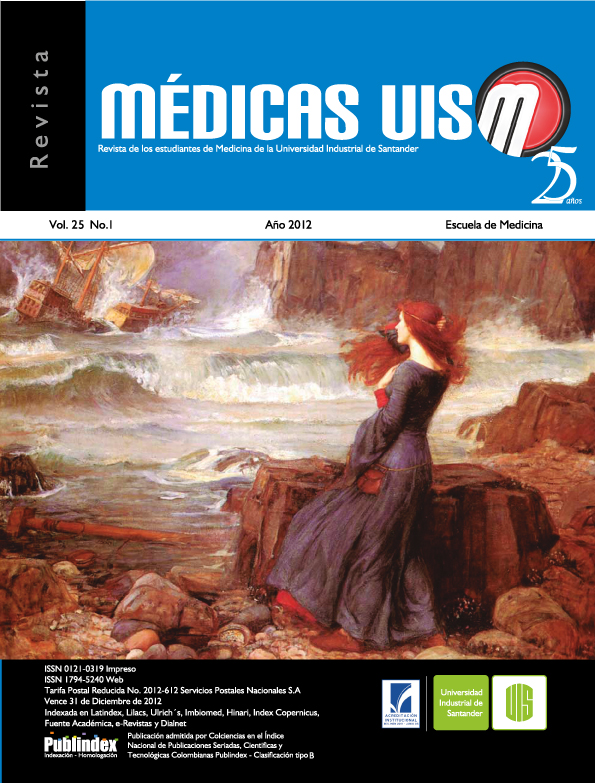Abstract
Rescan emergency cardiovascular surgery service Ameijeiras Brothers Hospital between 2008 and 2009.Introduction: approximately between 5% and 10% of the subjected patients to cardiovascular surgery require of an urgent reexploratión.It is the postoperative bleeding the first cause of reintervention of urgency in an operated patient of cardiovascular surgery. The presentwork seeks to show the behavior of the reexploratión in operated patients of heart surgery in the service and to determine which themain factors of risk were associated to this to proceed as well as the evolution and the behavior of the costs. Objective: determinethe risk factors of emergency reintervention in cardiovascular surgery and to evaluate the hospital costs of reintervention. Materialsand Methods: it was performed a retrospective case-control study (cases n=47, controls n=916) in the Cardiovascular Surgery Serviceof the Hospital “Hermanos Ameijeiras” on the period between January 2008 and December 2009. We compared variables such as: age,sex, weight, height, background, preoperative medication, use of blood and blood products, hours of mechanical ventilation, hospitalstay, development, mortality and hospital costs. Results: we found predisposing factors such as male gender, ischemic cardiomyopathy,rheumatic fever, infective endocarditis, hepatopathies, history of stroke and elevated creatinine levels.Preoperative intake of diuretics,anticoagulants and antiplatelet agents was associated with an increased number of reinterventions. Reintervention was associated withincreased consumption of blood and blood products, longer cardiopulmonary bypass, longer mechanical ventilation, increasedUCIQ andHospital stay, higher rate of infections, increased mortality and increasedcosts. 81% of the reoperations did not have a surgical cause.Conclusions: there is a set of parameters that act as risk factors for emergency reintervention. Reoperated patients had higher morbidityand mortality, and represented a greater cost to the health system. The use of a thromboelastograph would represent an annual savingof $ 350 000.(MÉD.UIS. 2012;25(1):11-7).
References
2. Unsworth-White MJ, Herriot A, Valencia O, Poloniecki J, Smith EE, Murday AJ, et al. Resternotomy for bleeding after cardiac operation: a marker for increased morbidity and mortality. Ann Thorac Surg. 1995;59:664-7.
3. Varela Crespo CA, Sanabria Carretero P, Palomero Rodríguez MA, Tormo las de Heras C, Rodríguez Pérez E, Goldman Tarlousky L. Efecto del ácido tranexámico en el sangrado postoperatorio de cirugía cardiaca en pediatría. Rev Esp Anestesiol Reanim. 2007;54(3):155-61.
4. Woodman RC, Harker LA. Bleeding complications associated with cardiopulmonary bypass. Blood. 1990;76(9):1680-97.
5. Dietrich W. Cardiac surgery and the coagulation system. Curr Opin Anesthesiol. 2000;13(1):27-34.
6. Thomas Yeh Jr, Minoo N Kavarana. Cardiopulmonary bypass and the coagulation system. Prog Pediatric Cardiol. 2005;21:87-115.
7. Charalambos CP, Zipitis CS, Keenan DJ. Chest Reexploration in the Intensive Care Unit After Cardiac Surgery: A Safe Alternative to Returning to the Operating Theater. Ann Thorac Surg. 2006;81:191-4.
8. Hall TS, Sines JC, Spotnitz AJ. Hemorrhage related reexploration following open heart surgery: the impact of pre-operative and post-operative coagulation testing. Cardiovasc Surg. 2002;10(2:146-53.
9. Dacey LJ, Munoz JJ, Baribeau YR, Johnson ER, Lahey SJ, Leavitt BJ, et al Reexploration for Hemorrhage Following Coronary Artery Bypass Grafting. Arch Surg. 1998;133:442-4.
10. Karthik S, Grayson AD, McCarron EE, Pullan DM, Desmond MJ. Reexploration for Bleeding After Coronary Artery Bypass Surgery: Risk Factors, Outcomes, and the Effect of Time Delay. Ann Thorac Surg. 2004;78:527-34.
11. Ranucci M, Bozzetti G, Ditta A, Cotza M, Carboni G, Ballotta A. Surgical Reexploration After Cardiac Operations: Why a Worse Outcome?. Ann Thorac Surg. 2008;86:1557-62.
12. Lemmer JH Jr, Stanford W, Bonney SL, Breen JF, Chomka EV, Eldredge WJ, et al. Aprotinin for coronary bypass surgery: efficacy, safety, and influence on early saphenous vein graft patency—a multicenter, randomized, double-blind, placebo-controlled study. J Thorac Cardiovasc Surg. 1994;107:543-53.
13. Creswell LL, Schuessler RB, Rosenbloom M, Cox JL. Hazards of postoperative atrial arrhythmias. Ann Thorac Surg. 1993;56:539-49.
14. Ottino G, DePaulis R, Pansini S, et al. Major sternal wound infection after open-heart surgery: a multivariate analysis of risk factors in 2,579 consecutive operative procedures. Ann Thorac Surg. 1987;44:173-9.
15. Salzman EW, Weinstein MJ, Reilly D, Ware JA. Adventures in hemostasis: desmopressin in cardiac surgery. Arch Surg. 1993;128:212-7.
16. Kirklin JW, Barratt-Boyes BG. Cardiac surgery. New York: Churchill Livingstone; 2nd ed. 1993. p.222-4.
17. Despotis GJ, Joist JH, Hogue CW, Alsoufiev A, Kater K, Goodnough LT, et al. The impact of heparin concentration and activated clotting time monitoring on blood conservation. J Thorac Cardiovasc Surg. 1995;110:46-54.
18. Hosmer DW, Lemeshow S. Applied logistic regression. New York: John Wiley; 1989.
19. Johnson JA, Gundersen AE, Stickney ID, Cogbill TH. Selective approach to sternal closure after exploration for hemorrhage following coronary artery bypass. Ann Thorac Surg. 1990;49:771-4.
20. Mannucci PM, Remuzzi G, Pusineri F, Lombardi R, Valsecchi C, Mecca G, et al. Deamino-8-Darginine vasopressin shortens the bleeding time in uremia. N Engl J Med. 1983;308:8-12.
